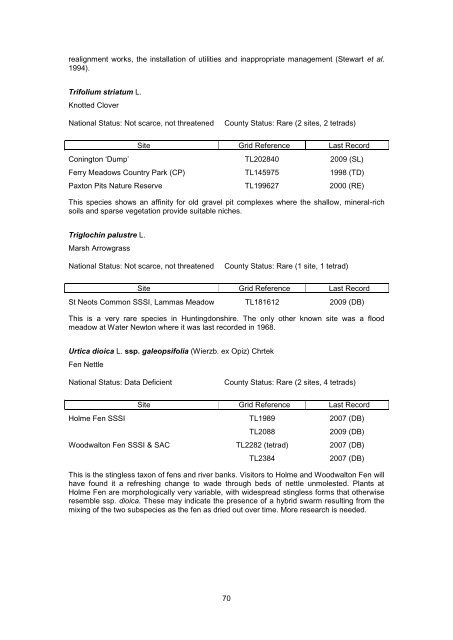Huntingdonshire - Botanical Society of the British Isles
Huntingdonshire - Botanical Society of the British Isles
Huntingdonshire - Botanical Society of the British Isles
You also want an ePaper? Increase the reach of your titles
YUMPU automatically turns print PDFs into web optimized ePapers that Google loves.
ealignment works, <strong>the</strong> installation <strong>of</strong> utilities and inappropriate management (Stewart et al.<br />
1994).<br />
Trifolium striatum L.<br />
Knotted Clover<br />
National Status: Not scarce, not threatened<br />
County Status: Rare (2 sites, 2 tetrads)<br />
Site Grid Reference Last Record<br />
Conington ‘Dump’ TL202840 2009 (SL)<br />
Ferry Meadows Country Park (CP) TL145975 1998 (TD)<br />
Paxton Pits Nature Reserve TL199627 2000 (RE)<br />
This species shows an affinity for old gravel pit complexes where <strong>the</strong> shallow, mineral-rich<br />
soils and sparse vegetation provide suitable niches.<br />
Triglochin palustre L.<br />
Marsh Arrowgrass<br />
National Status: Not scarce, not threatened<br />
County Status: Rare (1 site, 1 tetrad)<br />
Site Grid Reference Last Record<br />
St Neots Common SSSI, Lammas Meadow TL181612 2009 (DB)<br />
This is a very rare species in <strong>Huntingdonshire</strong>. The only o<strong>the</strong>r known site was a flood<br />
meadow at Water Newton where it was last recorded in 1968.<br />
Urtica dioica L. ssp. galeopsifolia (Wierzb. ex Opiz) Chrtek<br />
Fen Nettle<br />
National Status: Data Deficient<br />
County Status: Rare (2 sites, 4 tetrads)<br />
Holme Fen SSSI<br />
Woodwalton Fen SSSI & SAC<br />
Site Grid Reference Last Record<br />
TL1989<br />
TL2088<br />
TL2282 (tetrad)<br />
TL2384<br />
2007 (DB)<br />
2009 (DB)<br />
2007 (DB)<br />
2007 (DB)<br />
This is <strong>the</strong> stingless taxon <strong>of</strong> fens and river banks. Visitors to Holme and Woodwalton Fen will<br />
have found it a refreshing change to wade through beds <strong>of</strong> nettle unmolested. Plants at<br />
Holme Fen are morphologically very variable, with widespread stingless forms that o<strong>the</strong>rwise<br />
resemble ssp. dioica. These may indicate <strong>the</strong> presence <strong>of</strong> a hybrid swarm resulting from <strong>the</strong><br />
mixing <strong>of</strong> <strong>the</strong> two subspecies as <strong>the</strong> fen as dried out over time. More research is needed.<br />
70

















